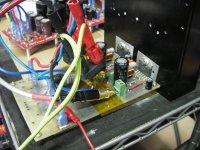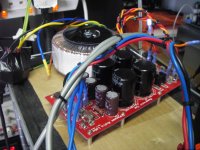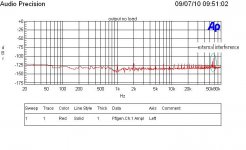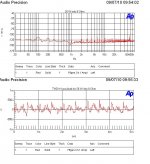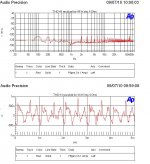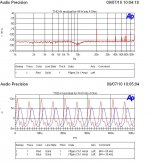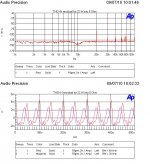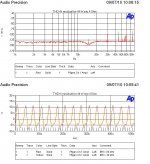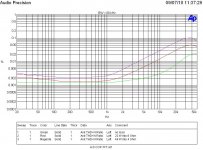To my knowledge, LM3886 is the most popular chip amp so far. I eventually also built one set for evaluation. I use the bear board given by a friend. The board is a two channel design together with the power supply. I did not populate the supply section. I use rails +/- 28 V, no load. The transformer is 330 VA.
Though LM3886 data sheet provides many plots for its distortion performance as well as CMRR and open-loop curves, it does not provide distortion FFT and distortion residual. These are valuable information since distortion content is more likely correlated with sonic performance. Tube amps exhibit high THD. But they are generally received promising comment for their sonic performance. Hence, I did my measurement to complement those available on the data sheet.
to complement those available on the data sheet.
Stay tuned! Pictures show the amp and its supply.
Though LM3886 data sheet provides many plots for its distortion performance as well as CMRR and open-loop curves, it does not provide distortion FFT and distortion residual. These are valuable information since distortion content is more likely correlated with sonic performance. Tube amps exhibit high THD. But they are generally received promising comment for their sonic performance. Hence, I did my measurement
 to complement those available on the data sheet.
to complement those available on the data sheet. Stay tuned! Pictures show the amp and its supply.
Attachments
To my knowledge, LM3886 is the most popular chip amp so far. I eventually also built one set for evaluation. I use the bear board given by a friend. The board is a two channel design together with the power supply. I did not populate the supply section. I use rails +/- 28 V, no load. The transformer is 330 VA.
Though LM3886 data sheet provides many plots for its distortion performance as well as CMRR and open-loop curves, it does not provide distortion FFT and distortion residual. These are valuable information since distortion content is more likely correlated with sonic performance. Tube amps exhibit high THD. But they are generally received promising comment for their sonic performance. Hence, I did my measurementto complement those available on the data sheet.
Stay tuned! Pictures show the amp and its supply.
Dear Panson,
I look very forward to your results! I respect and appreciate your continuous searching and trying out new things 😉
With kind regards,
Bas
Dear Panson,
I look very forward to your results! I respect and appreciate your continuous searching and trying out new things 😉
With kind regards,
Bas
Dear Bas,
Thank you for your encouragement!
Hope my work is not something redundant or meaningless. LM3886 can't compete with LME498xx at all in terms of technical data. However, it has been so widely accepted as a good audio chip amp. I want to try it and know it.
Cheers,
Panson
1 kHz test tone
Here are 1 kHz THD+N residual in time and frequency domain. Output level for 4 Ohm is reduced a little to 44 W since output clips at 52 W into 4 Ohm. I will use 22 W/8 Ohm and 44W/4 Ohm in the following tests.
For 8 Ohm load scenario, we practically have "distortion free" output. The harmonic levels are so low < -100 dBr compared to the fundamental. No single harmonic clearly dominates the distortion content.
For 4 Ohm load, third harmonic increases to barely higher than -100 dBr. It can be clearly seen from the time-domain residual. The level is still very low.
Here are 1 kHz THD+N residual in time and frequency domain. Output level for 4 Ohm is reduced a little to 44 W since output clips at 52 W into 4 Ohm. I will use 22 W/8 Ohm and 44W/4 Ohm in the following tests.
For 8 Ohm load scenario, we practically have "distortion free" output. The harmonic levels are so low < -100 dBr compared to the fundamental. No single harmonic clearly dominates the distortion content.
For 4 Ohm load, third harmonic increases to barely higher than -100 dBr. It can be clearly seen from the time-domain residual. The level is still very low.
Attachments
10 kHz test tone
Here are data for 10 kHz and 15 kHz test tones for 8 Ohm and 4 Ohm (from left to right).
Here are data for 10 kHz and 15 kHz test tones for 8 Ohm and 4 Ohm (from left to right).
Attachments
Hi Panson, those are interesting measurements, especially the FFTs.
Conventional wisdom would be that these chips sound their considerable best in active, multiway applications connected to efficient drivers. I wonder what the distortion spectrum would be like at lower power levels, say 1 W into 8 and 16 ohms at different frequencies?
Also, the distortion FFTs show even order components, especially into 8 ohms where 4th and 6th order seem to be a significant contribution to what little distortion there is. What happens if you bridged two of these chips across an 8 ohm or 16 ohm load? I'd guess the distortion levels would become very low, but it would be interesting to see FFT spectra to judge how effective that cancellation of even order components really is.
Just some ideas. 🙂
Conventional wisdom would be that these chips sound their considerable best in active, multiway applications connected to efficient drivers. I wonder what the distortion spectrum would be like at lower power levels, say 1 W into 8 and 16 ohms at different frequencies?
Also, the distortion FFTs show even order components, especially into 8 ohms where 4th and 6th order seem to be a significant contribution to what little distortion there is. What happens if you bridged two of these chips across an 8 ohm or 16 ohm load? I'd guess the distortion levels would become very low, but it would be interesting to see FFT spectra to judge how effective that cancellation of even order components really is.
Just some ideas. 🙂
Even order harmoniks is masking odd order, making the amp sounding better.
Since your ear is generating even order distortion in it self in addition to that almost all instruments produces the fundamental and even order tones, we are not at all so sensitive to even order distortion.Actually some third tone is also accepted by the brain, but not so well accepted as the 2nd.
Many listeners cant hear 2nd order distortions when its added to music by up to 6% and some people cant hear up to 10% !
So chasing 2nd order harmonics at 0.1% is... useless!
Martin P
Since your ear is generating even order distortion in it self in addition to that almost all instruments produces the fundamental and even order tones, we are not at all so sensitive to even order distortion.Actually some third tone is also accepted by the brain, but not so well accepted as the 2nd.
Many listeners cant hear 2nd order distortions when its added to music by up to 6% and some people cant hear up to 10% !
So chasing 2nd order harmonics at 0.1% is... useless!
Martin P
- Status
- Not open for further replies.
- Home
- Amplifiers
- Chip Amps
- I am also LM3886!
